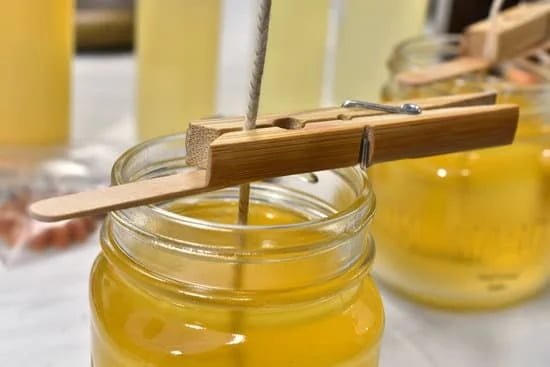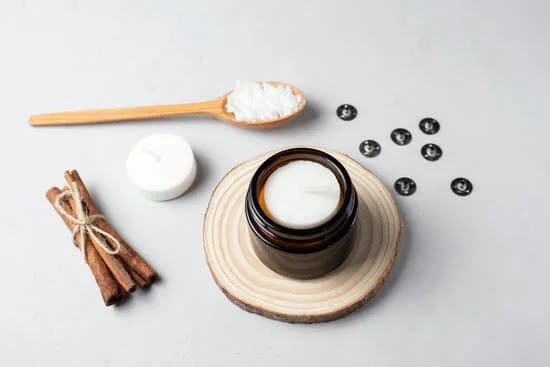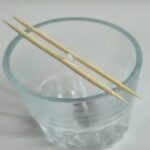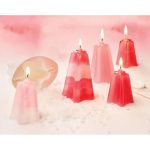Introduction
For those looking to utilize floral fragrances in their candle making process, you may be pleased to find that there are various benefits. Floral fragrances can be used to add a subtle yet inviting aroma to any space, providing an air of tranquility and relaxation. Many people find these particular scents comforting, creating an inviting atmosphere for guests or family members. Additionally, certain floral candles may act as aromatherapy agents by helping to ease stress and anxiety or creating a calming space for relaxation.
When it comes to choosing the best floral Candle for making, many opt for sweet-smelling citrus-based scents such as Lavender, Lily of the Valley or Rosemary as they work well with paraffin wax blends. Citrus fragrances also lend themselves more readily to a variety of other ingredients such as essential oils. Other popular fragrances include Jasmine, Ylang Ylang and Iris which have been known to evoke pleasant memories while providing a delicate fragrance. As with any type of product be sure always use high-quality essential oils if you’re looking for an extra burst of fragrance as you can get more bang for your buck when compared with perfume oils or synthetic blends. Natural beeswax, soy waxes and vegetable waxes all make excellent bases however bee’s wax will help capture the true essence of the particular flower fragrance being utilized better than alternative waxes due its natural scent binding properties.
Understanding the Types of Wax and Candle Making Supplies Needed
Before you start scenting your candles with floral fragrances, it is important to understand the basics of candle making. First, you will need to consider what type of wax you want to use. Paraffin is a common wax used for making all types of candles, as it has great scent holding properties. Soy wax is also increasingly popular due to its low melting point, eco-friendliness, and natural origins. There are other waxes out there that may be useful depending on what type of candle you are looking to craft.
In addition to selecting a wax type, you should also take into consideration the wick and containers needed for your project. Wick size should always match the diameter of the container or jar that your candle will be poured in; this prevents tunneling and burning unevenly. If you are using glass containers, it’s important to make sure they are heat safe for pouring melted wax in them at higher temperatures ” usually over 120 degrees Fahrenheit. Once these basic skills have been mastered, it’s time to select from an array of scents!
When it comes to choosing which floral scents are best for creating your own custom blend, essential oils such as lavender and jasmine offer sumptuous aromas perfect for relaxation or calm spaces. Tropical flower fragrances like hibiscus, magnolia blossoms and gardenias carry warm tones sure to evoke summer vibes all year long! To ensure proper scent throw (meaning how much fragrance a candle gives off) when burning, it’s recommended that 20% (by weight) is added during production stage ” this amount can be tweaked depending on desired strength of fragrance aroma released when lit. Lastly don’t forget about safety precautions while working with hot wax and melts; always consult specific instructions on product labels before beginning any part of the process!
Narrowing Down the Best Floral Scents for Your Candles
Finding the right scent for your candle can be daunting, especially if you want to choose a floral fragrance. There are hundreds of different floral aromas to choose from, each with its own unique characteristics and nuances. When selecting a floral aroma for your candles, it is important to consider how long the scent will linger, how strong the scent is, and how powerful the underlying notes are in order to create a balanced product that meets your needs. Fortunately, there are several floral scents that make excellent choices for candle making.
Lavender has been used as an aromatic herb since antiquity and is often associated with relaxation and calming properties. It is a popular choice due to its sweet and soothing aroma as well as its versatility in blending well with many other fragrances. Jasmine’s exotic and intensely sweet aroma has long been used in perfumes and other potpourris due to its well-rounded yet sweet masculine quality. Rose has similarly been enjoyed for centuries thanks to its deep emotionally evocative character; the perfect balance between masculine strength and feminine beauty. Other popular options for floral fragrances include geranium which features a herbal lemon-like scent, gardenia’s sweet powdery aroma, Frangipani ‘s delightful combination of honey-sweetness blended nicely with muskiness, magnolia’s delicate clean lemony flavor and cyclamen’s tart yet also sweet appealing fragrance.
Creating Your Own Signature Blends and Fragrances
When it comes to crafting your own signature scents, floral fragrances are some of the most commonly used. From sweet and subtle scents to heady and exotic aromas, floral fragrances can bring a wealth of luxurious aroma options to candle makers. Here are some of the best floral fragrances for candle making.
Jasmine: Jasmine has a distinctive, youthful scent that brings with it a bright and bubbly atmosphere. Sweetly seductive, this fragrance is perfect for creating romantic or summery candles. You can blend with other fragrances like bergamot or rose, to create slightly more complex scents.
Lavender: An ever popular choice, lavender is a classic, earthy scent that many people associate with fresh linen and sleeping soundly ” two qualities all candles should deliver! Lavender is great on its own or blended with chamomile and bergamot for an extra refreshing scent.
Rose: The unmistakable fragrance of rose is romantic, delicate and timeless; perfect for those who desire something both traditional and contemporary at the same time. Blending this powdery florality with some zesty citrus notes like grapefruit make it ideal for adding elegance to any candle scent composition you create.
Freesia: A light yet deeply perfumed fragrance makes freesia one of the best floral options for candle making. Suitable across different types of candles from tea lights to pillar candles in many different colours too; its versatile nature allows it to stand out even when blended with stronger aromas such as eucalyptus or orange blossom extractions.
Honeysuckle: Honeysuckle offers an oppulent aroma combination of sweet nectar and tangy tartness that creates an entrancing effect in any setting. Its notes have been long associated with succulence, joyfulness and festivity making it ideal for illuminating evenings after dark along with other complimentary ingredients such as nutmeg or cinnamon leaf oil extractions that warm up the entire atmosphere even further bringing comfort into any room on a chilly night!
Adding Essential Oils for Subtle Aromas
When creating a custom candle, adding essential oils can help take your candle making up a notch. Essential oils come in a variety of floral fragrances that can add subtle but pleasant aromas to your candles. Popular floral essential oils for use in candle-making include rose, lavender, chamomile, jasmine, plumeria (also known as frangipani), geranium and ylang-ylang. Depending on the scent you’re trying to achieve, experiment with different combinations until you find the one that best fits the mood and atmosphere you want to create. When using essential oils for candle making keep in mind that some essential oils evaporate faster than others and will need to be blended more frequently throughout the baking process for best results. Additionally make sure to select only those essential oils specifically made for aromatherapy use – because those are gentlest on candles and most effective at producing desired scent outcomes.
Utilizing Natural Essential Oils for Aroma Therapy
Using natural essential oils for candle making is an excellent way to create floral scents that delight the senses. Essential oils are extracted from plants and flowers and are most often used for their medicinal properties, which are both therapeutic and calming. When used in candle making, the natural essential oils provide not only a pleasant scent but a strong source of aroma therapy as well. Popular floral fragrances such as lavender, rose, jasmine, and lilac can be used alone or combined to make beautiful candles with powerful aromas that fill a room with a gentle essence. For those who prefer more intense aromas, combinations of citrus such as lemon, orange blossom and behind them floral notes such as lavender, chamomile, rosemary and white carnation will bring out the best properties of each note. Other variations include sweet-scented florals like bergamot or geranium combined with sandalwood or patchouli. All of these combinations yield unique scents that will provide an atmosphere of relaxation while creating a pleasant ambiance in any space they inhabit.
Avoiding Allergic Reactions
When making candles with essential oils, it can be hard to know which fragrances are best to use when avoiding possible allergic reactions. It’s important to remember that allergies can manifest differently in different people and the same person may have different reactions to different essential oils. There are, however, certain oils renowned for their low allergenic potential and these will make great fragrances for those concerned about possible allergic reactions.
Lavender is one such oil with a low allergy potential ” its sweet, herbaceous scent makes it a popular choice for candle making regardless of whether an allergy-concerned customer might purchase them or not. Peppermint is another popular choice as it can also provide an uplifting aroma while remaining low on allergenicity. Other floral scents like chamomile and geranium that can be safely used without fear of allergic responses include Jasmine, Sandalwood, Ylang Ylang and Rose. Though slightly more expensive than other oils, these are still worth considering due to the value they provide ” not only for their scent but also for their many therapeutic benefits as well. Lastly Grapefruit oil is becoming increasingly popular due to its ability to both invigorate and relax depending on how much is used and this too offers very low allergenic potential when used as a candle fragrance oil .
Mixing Fragrance Oils Properly
When it comes to creating the perfect candle, one of the most important things is mixing fragrance oils properly so that the scent is balanced and not too overpowering. The key is to use a mixture of different floral fragrances that complement each other but still manage to stand out on their own. Popular scents for candle making include lavender, rose, jasmine, lilac, magnolia, sweet pea, and gardenia. These fragrances can be combined in a variety of ways to create unique scents. For example, lavender can be combined with sweet pea for a delicate and calming aroma or mixed with magnolia for a lush and breezy feel. Rose and jasmine are often paired together as these both have deep feminine undertones. Lilac alone creates an uplifting atmosphere while added to gardenia produces a light floral breeze that’s perfect for summer evenings. With the right combination of scents and proper blending techniques, you can evoke an airy atmosphere in any living space.
Preferred Floral Aroma Combinations
Making your own floral fragrances for candles is a great way to create unique scents and aromas that are tailored to your personal tastes. There are many options available when it comes to selecting the perfect scent combinations, so it’s important to consider the way different fragrances interact with each other. To start with, some popular floral fragrance combinations include combining notes of rose and jasmine, gardenias and magnolia, lavender and sandalwood, or mimosa and daisy. Other popular scents that work well as accents when mixing more bold flower fragrances include citrus notes such as orange or bergamot, spicy notes like peppermint or cinnamon, or earthy tones from cedarwood or patchouli essential oils. When combining multiple fragrances it’s important to use a good base scent with softer fragrance layers which combine to make a beautiful aromatic experience. Additionally, adding seasonal essential oils such as pine needles in the winter or lilac in the spring can add intriguing layers of aroma for filling any room with a pleasant scent.
Wrapping Up
Crafting the perfect floral candle is an art form. It begins with selecting a scent that will reflect your senses and style. The best floral scents to use in candle making are those that evoke calming natural environments, including anything from sweet honeysuckle to refreshing lilac. For a warmer fragrance, consider choosing orange blossom or lavender notes which can lighten any atmosphere with their subtle fragrances. Once you’ve chosen the right fragrance, it’s important to consider wax type, wick size and color as these can all affect the burn of your candle. Take time to ensure your measurements are correct so the results are just as you would like them to be! Lastly, take a moment to appreciate and admire your handiwork; the best floral candles come alive through detailed attention and precision. With the perfect combination of scent and care for every step of production, you’ll have a beautifully scented candle that will fill any room with an aroma of relaxation and elegance.

Welcome to my candle making blog! In this blog, I will be sharing my tips and tricks for making candles. I will also be sharing some of my favorite recipes.





